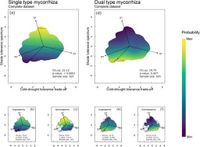In a groundbreaking study published in Scientific Reports, researchers have unveiled how different types of mycorrhizal interactions influence the ability of woody plants to cope with various abiotic stresses. Mycorrhizae, symbiotic relationships between fungi and plant roots, play a crucial role in plant health, particularly for woody species, which encompass nearly half of the world’s vascular plant diversity.
The investigation focused on 621 woody species, revealing that a single mycorrhizal type is linked with shade tolerance, while a dual type supports cold and waterlogging tolerance. Through a comprehensive analysis of how these symbiotic relationships function under multiple stressors, the researchers have identified significant patterns that underscore how these interactions are essential for plant survival.
The research illuminates critical interactions between woody plants and mycorrhizal fungi. Arbuscular mycorrhiza and obligate interactions were found to flourish under drought stress conditions, whereas ectomycorrhizal and facultative interactions were more prevalent in settings marked by cold and waterlogged environments. This nuanced understanding of mycorrhizal function highlights diverse and adaptive strategies in plant responses to environmental variations.
Employing a top-down approach, the researchers mapped stress tolerances and mycorrhizal interactions through overlapping heatmaps. Previous studies had primarily isolated stress factors, but this research integrates multiple stressors, enhancing our grasp of the symbiotic dynamics. Such comprehensive analysis establishes a framework for understanding how varying environmental conditions shape the effectiveness of these interactions across different biogeographic regions.
The study suggests that dual mycorrhizal types, which couple both arbuscular and ectomycorrhizal associations, tend to be more prominent in plants enduring cold and waterlogged stress. In contrast, single mycorrhizal associations are predominantly linked to shade tolerance strategies. These insights shed light on the evolutionary adaptations of woody plants, particularly in how they negotiate survival amidst shifting climatic scenarios.
Significantly, the findings indicate that ectomycorrhizal interactions have a vital role in addressing the challenges presented by cold, wet conditions, which could be crucial as climate change continues to impact global ecosystems. The research posits that woody species via mycorrhizal interactions can enhance their resilience against these stresses while also improving nutrient uptake—a necessary survival strategy under harsh conditions.
Furthermore, obligate interactions dominate the stress tolerance landscape, especially in shade tolerance contexts. This shows how closely plants have evolved with their fungal partners, optimizing both nutrient uptake and carbon conservation to thrive even with limited light—a vital trait for survival in nutrient-poor understory environments.
As scientists continue to dissect the complexities of plant-mycorrhizal dynamics, this study highlights the importance of broader ecological perspectives. Understanding the dualities of mycorrhizal associations and their contributions to woody plant strategies against abiotic stress is paramount. The research also opens pathways for future investigations exploring adaptive evolutionary responses of plants to ongoing environmental challenges.
This comprehensive analysis of mycorrhizal functionality in plant resilience represents a vital step forward in ecological research and offers vital insights into how woodland ecosystems can be better managed in light of rapid climate change.

